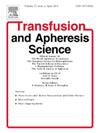卡非佐米联合血浆置换治疗抗体介导的肝移植排斥反应
IF 1.2
4区 医学
Q4 HEMATOLOGY
引用次数: 0
摘要
抗体介导的排斥反应(AMR)给肝移植患者带来了巨大的挑战,治疗指南推荐了多种方法,通常是将治疗性血浆交换(TPE)与免疫抑制治疗相结合,没有标准化的方案[1]。在这里,我们报告了两例肝移植后AMR患者,对多种治疗方案都难治,因此采用卡非佐米和TPE联合治疗。患者1在移植后2个月内接受治疗,在卡非佐米和TPE治疗后表现出显著的临床改善,肝功能测试(LFTs)和胆红素正常化,供体特异性抗体(DSA)水平降低。相反,患者2在移植后接受了7个多月的治疗,并且还患有慢性细胞排斥,间歇性地坚持使用门诊免疫抑制药物;尽管卡非佐米和TPE治疗后DSA水平略有下降,但患者的临床改善甚微,最终需要再次移植。总体而言,病例1表明卡非佐米联合TPE可以改善特定患者的预后,特别是早期AMR患者,而病例2强调了关键的并发症因素,包括伴随疾病进程和免疫抑制,因此强调了基于临床表现的个性化治疗策略的必要性。本文章由计算机程序翻译,如有差异,请以英文原文为准。
Combined use of Carfilzomib and plasmapheresis in antibody-mediated liver transplant rejection
Antibody-mediated rejection (AMR) poses significant challenges in liver transplant patients, and treatment guidelines recommend variable approaches which usually combine therapeutic plasma exchange (TPE) with immunosuppression therapies without standardized protocols [1]. Here we report two patients with AMR post-liver transplant refractory to multiple treatment regimens who were consequently treated with a combination of Carfilzomib and TPE. Patient 1 was treated within two months after transplant and demonstrated significant clinical improvement, normalization of liver function tests (LFTs) and bilirubin, and reduction in donor-specific antibody (DSA) levels following Carfilzomib and TPE. Conversely, Patient 2 was treated more than seven months after the transplant and additionally suffered from chronic cellular rejection with intermittent adherence to outpatient immunosuppressive medications; although DSA levels were marginally reduced following Carfilzomib and TPE, the patient showed minimal clinical improvement, ultimately necessitating a repeat transplant. Overall, Case #1 suggests that Carfilzomib combined with TPE can improve outcomes in select patients especially who have early AMR, while Case #2 highlights critical complicating factors including concomitant disease processes and immunosuppression, thus emphasizing the need for personalizing treatment strategies based on clinical presentation.
求助全文
通过发布文献求助,成功后即可免费获取论文全文。
去求助
来源期刊
CiteScore
3.60
自引率
5.30%
发文量
181
审稿时长
42 days
期刊介绍:
Transfusion and Apheresis Science brings comprehensive and up-to-date information to physicians and health care professionals involved in the rapidly changing fields of transfusion medicine, hemostasis and apheresis. The journal presents original articles relating to scientific and clinical studies in the areas of immunohematology, transfusion practice, bleeding and thrombotic disorders and both therapeutic and donor apheresis including hematopoietic stem cells. Topics covered include the collection and processing of blood, compatibility testing and guidelines for the use of blood products, as well as screening for and transmission of blood-borne diseases. All areas of apheresis - therapeutic and collection - are also addressed. We would like to specifically encourage allied health professionals in this area to submit manuscripts that relate to improved patient and donor care, technical aspects and educational issues.
Transfusion and Apheresis Science features a "Theme" section which includes, in each issue, a group of papers designed to review a specific topic of current importance in transfusion and hemostasis for the discussion of topical issues specific to apheresis and focuses on the operators'' viewpoint. Another section is "What''s Happening" which provides informal reporting of activities in the field. In addition, brief case reports and Letters to the Editor, as well as reviews of meetings and events of general interest, and a listing of recent patents make the journal a complete source of information for practitioners of transfusion, hemostasis and apheresis science. Immediate dissemination of important information is ensured by the commitment of Transfusion and Apheresis Science to rapid publication of both symposia and submitted papers.

 求助内容:
求助内容: 应助结果提醒方式:
应助结果提醒方式:


